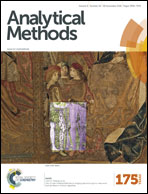Novel synthesis of chitosan protected platinum nanoparticles based on gas–liquid interfacial reactions and their application for electrochemical sensing of hydrogen peroxide
Abstract
A gas–liquid interface will be formed when volatilized methyl aldehyde gas begins to dissolve in solution, and metal ions in solution will be reduced slowly under appropriate experimental conditions, offering an effective way for the controlled synthesis of metal nanomaterials (NPs) without aggregation. Herein, we developed a novel controllable synthesis of platinum nanoparticles (Pt NPs) based on the gas–liquid interfacial reaction. The obtained Pt NPs were characterized by transmission electron microscopy and X-ray diffraction. Then, the Pt NPs were applied for electrochemical sensing, indicating that they had excellent properties to catalyze H2O2, and could detect H2O2 with a low detection limit of 0.05 μM in a wide linear range of 0.5–375 μM. This study may provide a general platform for the controlled synthesis of nanomaterials and can be extended to other optical, electronic, and magnetic nanocompounds.


 Please wait while we load your content...
Please wait while we load your content...